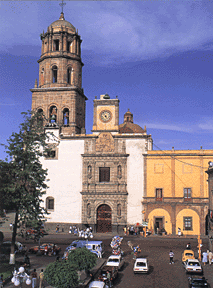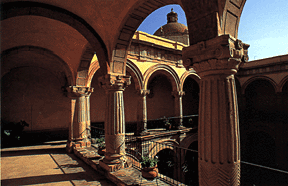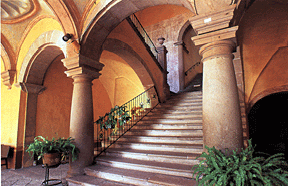QUERETARO
REGIONAL MUSEUM OFFERS A WINDOW INTO MEXICAN HISTORY
by Bob
Brooke
 Queretaro
is both a city of religion and history. Every block houses a convent or
a church. It was also the stage for some of the greatest events in
Mexican history. The 1917 Constitution was signed here, events that
accelerated the proclamation of Independence took place in its colonial
buildings, and the city witnessed the downfall of Maxmillian, the
pretender king. For today's visitor, remembrances of the past can be
found in the city's Regional Museum, housed in the old San Francisco
Convent. Queretaro
is both a city of religion and history. Every block houses a convent or
a church. It was also the stage for some of the greatest events in
Mexican history. The 1917 Constitution was signed here, events that
accelerated the proclamation of Independence took place in its colonial
buildings, and the city witnessed the downfall of Maxmillian, the
pretender king. For today's visitor, remembrances of the past can be
found in the city's Regional Museum, housed in the old San Francisco
Convent.
The Renaissance-style building is a local
variety of the baroque, a serene structure with wide-open patios,
corridors, flowery arches, and elegant stairways. The16th-century
Convent of San Francisco, which also served as a fort during Maxmillian’s
reign and as a hospital and surgery ward for American troops in 1867,
adjoins the church of the same name. Its spacious atrium–the broad
area in front of the church where the unbaptizede Indians used to gather
to hear mass, has been eaten up by Avenida Corregidora, so that the
church’s enclosed arches and windows now seem alarmingly close to the
curb. The atrium of the Convent is now occupied by both the Plazas de la
Constitucion and Galerias, as well as a large portion of the Zenea
Garden.
 The
cloister within the Convent, begun by Sebastian Bayas Delgado in 1660,
is undoubtedly one of the most beautiful in Mexico. Although the
ambulatories are somewhat narrow, the open areas and courtyard are
enormous, with an unquenchable thirst for light. The combination of
repeated concentric lines in blue, yellow and pink creates a truly
outstanding rhythm. This enthusiasm runs over into the great stucco
flowers that form the vaults above the ambulatories. The
cloister within the Convent, begun by Sebastian Bayas Delgado in 1660,
is undoubtedly one of the most beautiful in Mexico. Although the
ambulatories are somewhat narrow, the open areas and courtyard are
enormous, with an unquenchable thirst for light. The combination of
repeated concentric lines in blue, yellow and pink creates a truly
outstanding rhythm. This enthusiasm runs over into the great stucco
flowers that form the vaults above the ambulatories.
The tower of the Church of San Francisco,
adjoining the convent, rises from a square base to an octagonal section
and finally flows into a rounded section at the top, representing
strength, intelligence and sensuality, respectively. It served as the
city’s cathedral for 200 years.
The museum, established in 1936, displays
exhibits covering the prehistoric, colonial, independence, imperial,
revolution and post-revolution periods of Mexican history.
Historic
Treasures
Among its many items, the Queretaro Regional Museum contains many unique
objects such as the jawbone of an animal that lived in the Sierra Gorda
region millions of years ago and pre-Hispanic vases which, despite their
primitive nature, bear drawings that dazzle the eyesight like the midday
sun. The collection is greatly enhanced by features such as the museum’s
Otomi Room and the curious portrait of Nicolas Montanez, an Otomi
captain who, like Fernando de Tapia, fought alongside the Spaniards on
Sangremal Hill.
Then there are the bloody portraits of Juan
Diaz and Jose Moreno, two of the first missionaries to reach Sonora,
subsequently executed by indigenous warriors on the banks of the
Colorado River on July 17, 1781, as well as the fantastic portrait of
Jose Escandon, Count of Sierra Gorda and killed while wearing the
brilliant white cape of the Knights of Santiago. The painting, The
Education of the Virgin by Luis Juarez, done in 1615, is an allegory of
the alliance between Spain and England against Napoleon, painted at the
beginning of the 19th Century by Jose Castro. There’s also
the Archangels of the Passion, an anonymous 17th-century painting.
Two small city maps, one drawn on canvas and
the other on parchment, are also worth noting.
 In
addition, the museum incorporates the Pio Mariano Museum, considered by
many to be one of the finest museums in the country outside Mexico City.
It houses many colonial relics, including paintings by Miguel Cabrera
and an outstanding library of more than 8,000 books, mostly parchment
manuscripts from the 17th and 18th centuries. Some huge hand-lettered
choir books, intended to be legible to the singers in a gallery above
the choirmaster, are especially noteworthy. In
addition, the museum incorporates the Pio Mariano Museum, considered by
many to be one of the finest museums in the country outside Mexico City.
It houses many colonial relics, including paintings by Miguel Cabrera
and an outstanding library of more than 8,000 books, mostly parchment
manuscripts from the 17th and 18th centuries. Some huge hand-lettered
choir books, intended to be legible to the singers in a gallery above
the choirmaster, are especially noteworthy.
Not All Exhibits Are
Noteworthy
But not all the exhibits in the Regional Museum are worth seeing, so
visitors should be selective. The collection of religious paintings, for
example, isn't as interesting as that at Tepotzotlan. The most
interesting historical items include the keyhole and door latch of a
house where Josefa Otiz de Dominguez, also known as La Corregidora, was
under house arrest. Through it she whispered instructions to a neighbor
to get a horse and warn the Allende brothers and Father Hidalgo that
their plot had been discovered. As a result of this information the date
of the revolution was pushed ahead by three months.
In the same exhibit is the table on which the
Treaty of Guadalupe Hidalgo was signed in Queretaro in 1848 by interim
Mexican President Manuel de la Pena y Pena. Although Mexico's foreign
relations minister and the U.S. representative signed the treaty
elsewhere, the exchange of government ratifications took place in
Queretaro. A plaque near the table notes that Mexico turned over to the
U.S. the territory of Texas, the territory between the Nueces and Bravo
(Rio Grande) Rivers belonging to the state of Tamaulipas, the territory
of New Mexico, and the territory of Alta (Upper) California. The plaque
states, "Mexico ceded no territory from the states of Sonora and
Chihuahua and maintained land communications with Baja California though
Sonora," adding that "Mexico lost 851,598 quare miles of
territory for which the United States paid Mexico $15 million in
compensation."
In an adjoining room stands the desk at which
sat the council of war that heard the case of Emperor Maxmillian and
signed his death sentence in the Teatro de la Republica in 1867.
Also on display is the flatbed press,
manufactured by Walter Scott and Co. of Plainfield, New Jersey, that
printed the first copies of the 1917 Political Constitution of the
United Mexican States, still in effect today. The museum is free but is
closed on Mondays. |

